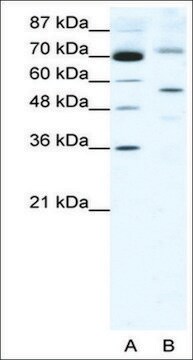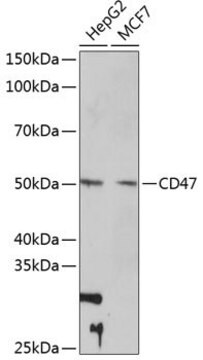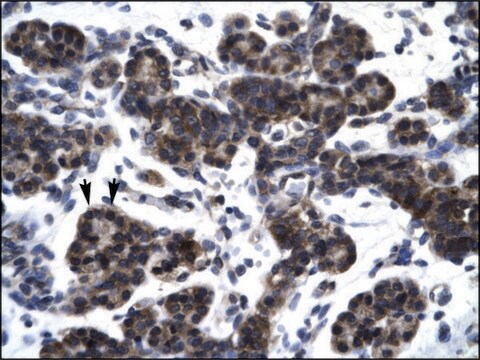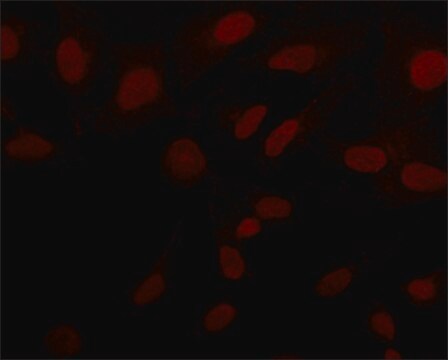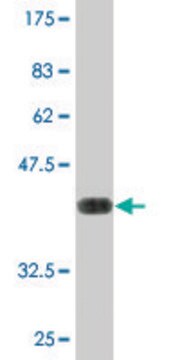추천 제품
생물학적 소스
rabbit
Quality Level
결합
unconjugated
항체 형태
affinity isolated antibody
항체 생산 유형
primary antibodies
클론
polyclonal
양식
buffered aqueous solution
분자량
26 kDa
종 반응성
rat, guinea pig, dog, bovine, human, mouse, rabbit
농도
0.5 mg - 1 mg/mL
기술
immunohistochemistry: suitable
western blot: suitable
NCBI 수납 번호
UniProt 수납 번호
배송 상태
wet ice
저장 온도
−20°C
타겟 번역 후 변형
unmodified
유전자 정보
human ... MXI1(4601)
일반 설명
Max interactor 1 (MXI1) is a bHLH-Zip containing protein that associates with Max to bind Myc-Max recognition sites. MXI1 mutations have been linked to prostate cancer.
Rabbit Anti-MXI1 antibody recognizes human, mouse, rat, chicken, bovine, zebrafish, and canine MXI1.
Rabbit Anti-MXI1 antibody recognizes human, mouse, rat, chicken, bovine, zebrafish, and canine MXI1.
면역원
Synthetic peptide directed towards the middle region of human MXI1
애플리케이션
Rabbit Anti-MXI1 antibody can be used for western blot applications at 1μg/ml.
생화학적/생리학적 작용
Expression of the c-myc gene, which produces an oncogenic transcription factor, is tightly regulated in normal cells but is frequently deregulated in human cancers. The MXI1 gene encodes a transcriptional repressor protein thought to negatively regulate MYC function, and is therefore a potential tumor suppressor. This protein inhibits the transcriptional activity of MYC by competing for MAX, another basic helix-loop-helix protein that binds to MYC and is required for its function. Defects in MXI1 are frequently found in patients with prostate tumors.Expression of the c-myc gene, which produces an oncogenic transcription factor, is tightly regulated in normal cells but is frequently deregulated in human cancers. The protein encoded by this gene is a transcriptional repressor thought to negatively regulate MYC function, and is therefore a potential tumor suppressor. This protein inhibits the transcriptional activity of MYC by competing for MAX, another basic helix-loop-helix protein that binds to MYC and is required for its function. Defects in this gene are frequently found in patients with prostate tumors. Three alternatively spliced transcripts encoding different isoforms have been described. Additional alternatively spliced transcripts may exist but the products of these transcripts have not been verified experimentally.
서열
Synthetic peptide located within the following region: LNKAKAHIKKLEEAERKSQHQLENLEREQRFLKWRLEQLQGPQEMERIRM
물리적 형태
Purified antibody supplied in 1x PBS buffer with 0.09% (w/v) sodium azide and 2% sucrose.
면책조항
Unless otherwise stated in our catalog or other company documentation accompanying the product(s), our products are intended for research use only and are not to be used for any other purpose, which includes but is not limited to, unauthorized commercial uses, in vitro diagnostic uses, ex vivo or in vivo therapeutic uses or any type of consumption or application to humans or animals.
적합한 제품을 찾을 수 없으신가요?
당사의 제품 선택기 도구.을(를) 시도해 보세요.
Storage Class Code
10 - Combustible liquids
WGK
WGK 3
Flash Point (°F)
Not applicable
Flash Point (°C)
Not applicable
가장 최신 버전 중 하나를 선택하세요:
L R Eagle et al.
Nature genetics, 9(3), 249-255 (1995-03-01)
The Mxi1 protein negatively regulates Myc oncoprotein activity and thus potentially serves a tumour suppressor function. MXI1 maps to chromosome 10q24-q25, a region that is deleted in some cases of prostate cancer. We have detected mutations in the retained MXI1
A S Zervos et al.
Cell, 72(2), 223-232 (1993-01-29)
We used the interaction trap to isolate a novel human protein that specifically interacts with Max. This protein, Mxi1 (for Max interactor 1), contains a bHLH-Zip motif that is similar to that found in Myc family proteins. Mxi1 interacts specifically
C L Pang et al.
Oncogene, 33(31), 4039-4049 (2013-10-22)
High-risk human papillomaviruses are causative agents of cervical cancer. Viral protein E7 is required to establish and maintain the pro-oncogenic phenotype in infected cells, but the molecular mechanisms by which E7 promotes carcinogenesis are only partially understood. Our transcriptome analyses
자사의 과학자팀은 생명 과학, 재료 과학, 화학 합성, 크로마토그래피, 분석 및 기타 많은 영역을 포함한 모든 과학 분야에 경험이 있습니다..
고객지원팀으로 연락바랍니다.